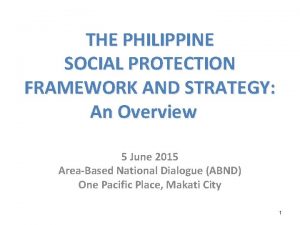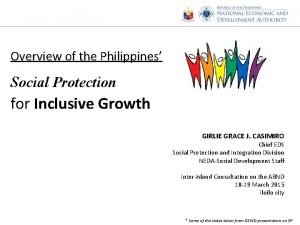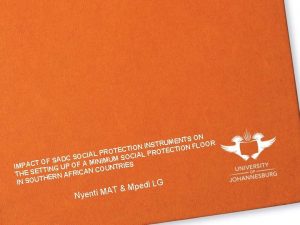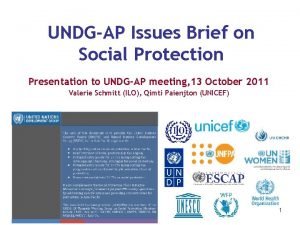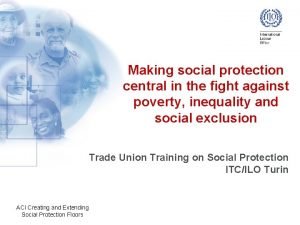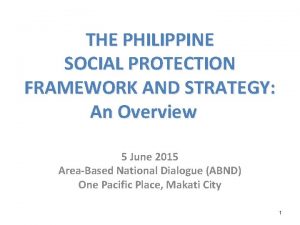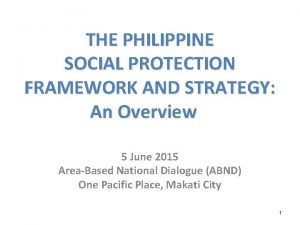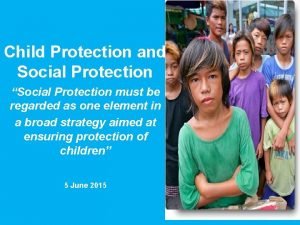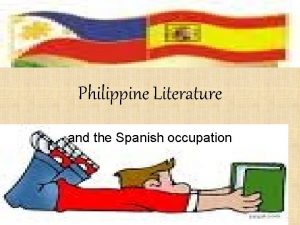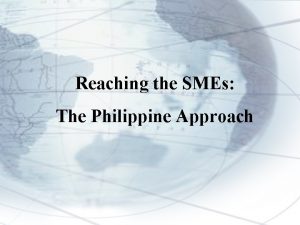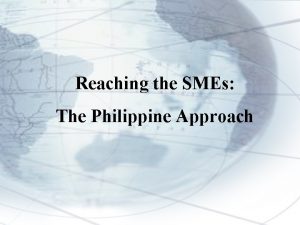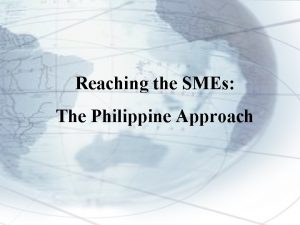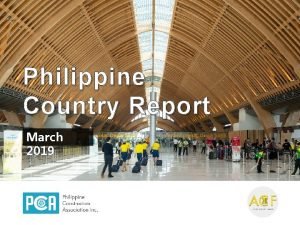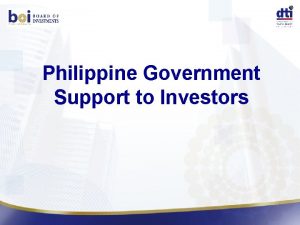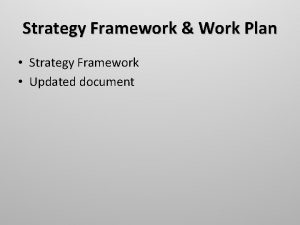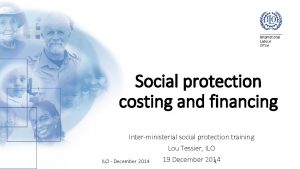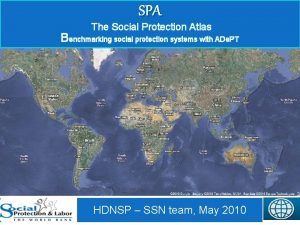THE PHILIPPINE SOCIAL PROTECTION FRAMEWORK AND STRATEGY An

























- Slides: 25

THE PHILIPPINE SOCIAL PROTECTION FRAMEWORK AND STRATEGY: An Overview 5 June 2015 Area-Based National Dialogue (ABND) One Pacific Place, Makati City 1

OUTLINE OF PRESENTATION I. The Philippine Definition of Social Protection II. The Social Protection Operational Framework and Strategy III. Other SP Initiatives Social Protection Handbook 2


WHY WE NEED SOCIAL PROTECTION? Filipino families, whether poor or non-poor, face various economic, environmental and human-made risks. Managing such risks is important for families to prevent them from falling into, falling deeper, and trapped into, poverty. Many poor are being left behind.

Movement in and out of Poverty (Tomas Africa, 2011) poverty threshold D C B A 5

WHY WE NEED A SOCIAL PROTECTION DEFINITION • To harmonize existing SP definitions - World Bank (WB) - Asian Development Bank (ADB) - International Labour Organization (ILO) - Institute for Development Studies

Official SP Definition SDC Resolution No. 1 Series of 2007 Social Protection constitutes policies and programs that seek to reduce poverty and vulnerability to risks and enhance the social status and rights of the marginalized by promoting and protecting livelihood and employment, protecting against hazards and sudden loss of income, and improving people’s capacity to manage risks. (adopted in 2007 by the SDC Cabinet Level)

Social Protection Policies NEDA-SDC Resolution No. 1, series of 2007 “Adopting a Philippine Definition of Social Protection” v Harmonized existing SP Definitions of WB, ADB, ILO, Institute of Development Studies, NAPC v An inter-agency sub-committee mechanism under NEDASDC which leads the operationalization of the Social Protection Strategy. This is being chaired by DSWD and cochaired by NEDA. v Presented by DSWD and approved by the SDC-Cabinet Level members during its SDC-CL meeting on May 18, 2012. v The core of the framework is the underlying purpose and objective of social protection which is better and improved quality of life for its beneficiaries. Philippine Development Plan 20112016: Chapter on Social Development v The Plan sums up the administration’s chosen economic direction and defines its strategies and programs for the next six years Joint Memorandum Circular No. 1, series of 2015 v The JMC enjoined all Provinces, Cities and Municipalities to use the Social Protection Handbook for Local Planning, Implementing, Monitoring and Evaluating SP Programs NEDA-SDC Resolution No. 2 series of 2009: “Sub-Committee on Social Protection (SCSP) under the NEDA Social Development Committee (NEDA SDC)” NEDA-SDC Resolution No. 3 series of 2012: Approving and Adopting the SP Operational Framework

SP Components Labor market intervention measures aimed at enhancing employment opportunities and protection of the rights and welfare of workers Social welfare preventive and developmental interventions that seek to support the minimum basic requirements of the poor

SP Components Social insurance seeks to mitigate income risks by pooling resources and spreading risks across time and classes Social safety nets stop-gap mechanisms or urgent responses that address effects of shocks on specific vulnerable groups

Definitions: Poor, Vulnerable & Marginalized • Poor : Families whose income fall below the poverty threshold as defined by the government and/or those that cannot afford in a sustained manner to provide their basic • Vulnerable refers to households confronted by ex-ante risk that if currently non-poor, will fall below the poverty line, or if currently poor, will remain in poverty. (NEDA) • Marginalized people are those groups in society who, for reasons of poverty, geographical inaccessibility, culture, language, religion, age, gender, migrant status or other disadvantage, have not benefited from health, education, employment and other opportunities, and who are relegated to the sidelines of political persuasion, social negotiation, and economic bargaining.

The Social Protection Framework and Strategy


Definitions: Risk, Poverty and Vulnerability • Risk and Shock: Uncertain event that may damage someone’s well-being leading to poverty ; Risks are pervasive, but information on risks and shocks is mostly scarce in a developing country • Poverty: Income or spending is insufficient to ensure a minimum level or state of well-being ( below an official threshold) • Vulnerability: Probability to become poor in the future; sources of vulnerability are risks and shocks and lack of physical, social and human capital to withstand shocks

Identify the Different Kinds of Risks and Vulnerabilities Individual and Life Cycle Risks – from womb till the tomb Environment and Disaster Risks – related to disaster Economic Risks – related to employment and income • Social and Governance Risks – crime related, rebellion and corruption

Types of Social Risks and Vulnerabilities Social Risks Vulnerabilities Individual Life-cycle Economic hunger, illness, disability, old age, death Environmental and Natural typhoons, drought, floods, earthquakes, volcanic eruption Social and Governance armed conflicts, crime, corruption, social exclusion and discrimination unemployment, underemployment, low and irregular incomes; economic crises

Vulnerable Groups Affected by Major Social Risks in Phil. Group or Sector Children: 0 – 5 years old 6 – 14 years old Risks and Vulnerabilities Illness and death, hunger and malnutrition, stunted growth Poor education quality Youth: 15 – 24 years old Low human capital, unemployment underemployment, substance abuse Elderly: 65 years old and above Illness and death, low or lack of income Women Large family size, domestic unemployment and underemployment People with disabilities (PWDs) Low human capital, unemployment and underemployment, lack of access to services Indigenous People Rural and Urban Informal Communities and violence, Dislocation due to armed conflicts, natural disasters, development projects, lack of shelter and housing, access to water and sanitation Dislocation due to armed conflicts, natural disasters and demolitions, lack of shelter and housing, access to water and sanitation

Four Types of SP Responses • Protective: ensure that basic needs are met (price control) • Preventive: done before risk occurs; mainly reducing the probability of risk occurring (vaccination, preventive health care) ü Mitigating help individuals reduce the impact of future risky event (crop and health insurance; savings and food storage) ü Coping mechanisms alleviate impact of risk once it occurred (relief and rehabilitation) ü Adapting mechanisms/resilience prepare individuals and households for the next shock and risk (disaster preparedness, fund availability) • Promotive: allows people to save and invest (access to credit) • Transformative helps people and communities build deeper adaptive capacities (ordinance for children and women protection, funds for disaster relief)

IMPLEMENTATION STRATEGY FOR SP CONVERGENCE Act of directing complementary and or synergetic programs or interventions to specified targets - poor households, families, individuals and or communities. It calls for the synchronization and coordination of all interventions of the government (national and local) and the private sector in one geographical area to ensure that reforms in terms of poverty alleviation, among others, are achieved.

Rationale for a CONVERGENCE Strategy • Vulnerability and poverty incidence are high • The most effective approach is multidimensional and multi-stakeholder • Limited resources of government • Varying capacities of national agencies and local government; pooling expertise is key • Avoidance of overlaps and duplication of projects and programs

Types of Convergence • Horizontal Inter-agency (SP Cluster Component Convergence, Social Security Cluster or Social Safety Net Clusters) • Horizontal Inter-agency at various levels (National, regional, local) • Vertical Intra-agency (National-regional-local coordination for a specific project or program) • Multi-level - combines vertical and horizontal (Bottom up budget; local poverty reduction plan) • Area-based or Sector based (specific target-based)

Social Protection Multi-level CONVERGENCE VERTICAL AND INTRA AGENCY CONVERGENCE (WITHIN AGENCIES AND NAT’L-LOCAL COVERGENCE) LEVELS ACTIVITIES FOR CONVERGENCE NATIONAL REGIONAL PROVINCIAL CITY/MUNICIPAL STAKE HOLDERS: Government CSOs, FBOs, Academe and Private Sector BARANGAY HORIZONTAL, INTER-AGENCY AND INTRA-LOCAL CONVERGENCE (TARGET AREAS AND SECTOR) Poverty, Risks and Vulnerability Analysis Targeting Policy Formulation Program and Budget Planning Implementation Monitoring & Evaluation

Other SP Initiatives Social Protection Handbook 23

OTHER INITIATIVES ON SP . • Development of Social Protection Handbook (for Implementers & Local Chief Executives) • Development of Social Protection and Vulnerability Assessment Manual • Conduct of Training of Trainers on the Use of the Social Protection Handbook

CHRISTIAN THOMAS DELORIA Policy Development and Planning Division Department of Social Welfare and Development 25
 Social protection operational framework philippines
Social protection operational framework philippines Social protection operational framework philippines
Social protection operational framework philippines Data protection act in health and social care settings
Data protection act in health and social care settings Data protection strategy template
Data protection strategy template Theoretical and conceptual framework in research example
Theoretical and conceptual framework in research example Social thinking social influence social relations
Social thinking social influence social relations Social thinking social influence social relations
Social thinking social influence social relations Social protection instruments
Social protection instruments Social protection
Social protection Ilo social protection
Ilo social protection Corporate strategy vs business strategy
Corporate strategy vs business strategy Chase demand strategy
Chase demand strategy Dispositional framework vs regulatory framework
Dispositional framework vs regulatory framework Climate change theoretical framework
Climate change theoretical framework Conceptual framework theoretical framework
Conceptual framework theoretical framework Dispositional framework vs regulatory framework
Dispositional framework vs regulatory framework Conceptual framework vs theoretical framework
Conceptual framework vs theoretical framework Hát kết hợp bộ gõ cơ thể
Hát kết hợp bộ gõ cơ thể Frameset trong html5
Frameset trong html5 Bổ thể
Bổ thể Tỉ lệ cơ thể trẻ em
Tỉ lệ cơ thể trẻ em Chó sói
Chó sói Tư thế worm breton
Tư thế worm breton Chúa sống lại
Chúa sống lại Các môn thể thao bắt đầu bằng từ đua
Các môn thể thao bắt đầu bằng từ đua Thế nào là hệ số cao nhất
Thế nào là hệ số cao nhất
